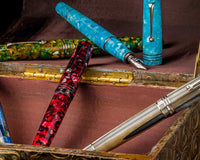While exploring the fountain pen world, you may have come across dip pens as well. These writing tools were used before modern fountain pens were developed in the 19th century. Today, they are mainly used in calligraphy, illustration, and even comics. Many fountain pen enthusiasts enjoy dip pens to experiment with different types of ink without having to fill several fountain pens at the same time. One common question that arises with the use of dip pens is whether fountain pen ink can be used with them. Here, we’ll cover the differences between fountain pens and dip pens and explore whether fountain pen ink can be used for dip pens.
Types of pens
There are many similarities between fountain pens and dip pens, but they also have distinct differences that set them apart in terms of how they are used, mainly the ink reservoir and the curvature of the nibs.
Fountain pens

Unlike dip pens, fountain pens have a built-in ink reservoir. How fountain pens work is by drawing the ink out through the nib using capillary action. Fountain pens are typically used to handle water-based inks. They also usually feature fine craftsmanship.
Dip pens

Dip pens, also called nib pens, employ technology used during the early days of writing. These pens eventually replaced quill pens that were widely used before.
This type of pen needs to pick up enough ink to write consistently. However, since it has no built-in reservoir that feeds ink into the pen, it has two essential features. First, there is an outside reservoir on the tip in the form of an oval shape. Second, there is a slightly concave curvature that helps hold some of the ink on the backside of the nib, aided by surface tension.
Compared to fountain pens, dip pens tend to be more affordable and less elaborately designed.
Can fountain pen ink be used for dip pens?

Given the differences between fountain pens and dip pens, can fountain pen ink be used for the latter?
The answer is it depends on the characteristics of the fountain pen ink.
Fountain pen ink is typically water-based and designed to be thin, smooth-flowing, and water-soluble. This allows it to flow easily through the body of a fountain pen, to the nib, and onto paper. Such ink does not stick to other surfaces other than paper, and it does not cling to metals.
These qualities are not ideal for dip pens, but it doesn’t mean they cannot be used for dip pens at all. This is because dip pens are designed to trap and store a small amount of ink in the nib.
Dip pens work by letting the ink flow off the nib as the tip is dragged along the paper. The thin texture and low viscosity of fountain pen ink and its inability to cling to metal means that dip pens will not be able to pick up this type of ink very well. Fountain pen inks will also flow from the nib very quickly, dripping off the tip rather than flowing smoothly and slowly, as is ideal.
Dip pen inks are designed differently from fountain pen inks. It is substantially thicker as it is made of pigments that are finely ground up and mixed with a solvent. Given this, they cannot be used in fountain pens driven by capillary action; they will simply clog it up. Some varieties, like India Ink from J. Herbin, contain gum Arabic, a thickening agent that may further clog fountain pens.
Dip pens are designed to let ink flow all over the nib's surface until it reaches the tip. This is how it collects ink and retains it until it is written with. Fountain pen ink, on the other hand, is designed to flow quickly.
That said, some fountain pen inks are thick enough to work well with dip pens. It depends on the fountain pen ink manufacturer and how they have formulated their inks to be used.
The bottom line
Dip pens are versatile in that they allow you to experiment with different types of ink. While fountain pen inks are not ideal for dip pens, some can be used, especially those with a thicker texture. Still, it is best to use drawing ink, pigment ink, India Ink, or China Ink with dip pens.
Happy inking and happy writing!
By Some Folks at EndlessPens








1 comment
Tammy Powers
Recently I purchased a very large variety of fountain pen ink samples. Pilot, Sailor, J Hardin, Ferris Wheel, Diammin, Noodlers and many others. Over 8 brands and different colors and viscosity’s in all. In order to create a sample book of all of these colors so that I could see how they looked when written with, dry times and how they “smeared”. I used a dip pen to test all 50 of them on a 100 gsm paper. Every single one of the performed great except for the Noodlers which feathered, however I would like to point out that Noodlers seems to feather with my fountain pens as well. If you wish to try a particular fountain ink color for your dip pens, I suggest purchasing a small sample to try out first. It’s very inexpensive that way and you will know right away if the ink will work for you. You can also add gum Arabic to the color to add some viscosity to it. I love buying samples! Why? To try different colors and to try mixing my own colors. Sometimes mixing colors comes out bad after 2 days they may become gummy and you don’t want to use them in your pen, or the color comes out odd. But it is fun experimenting. Never put experimental inks into your fountain pens until you know they flow well after two days, and if they have iridescence in them, better to use in a bold nib pen…for your dip pens though, go crazy!